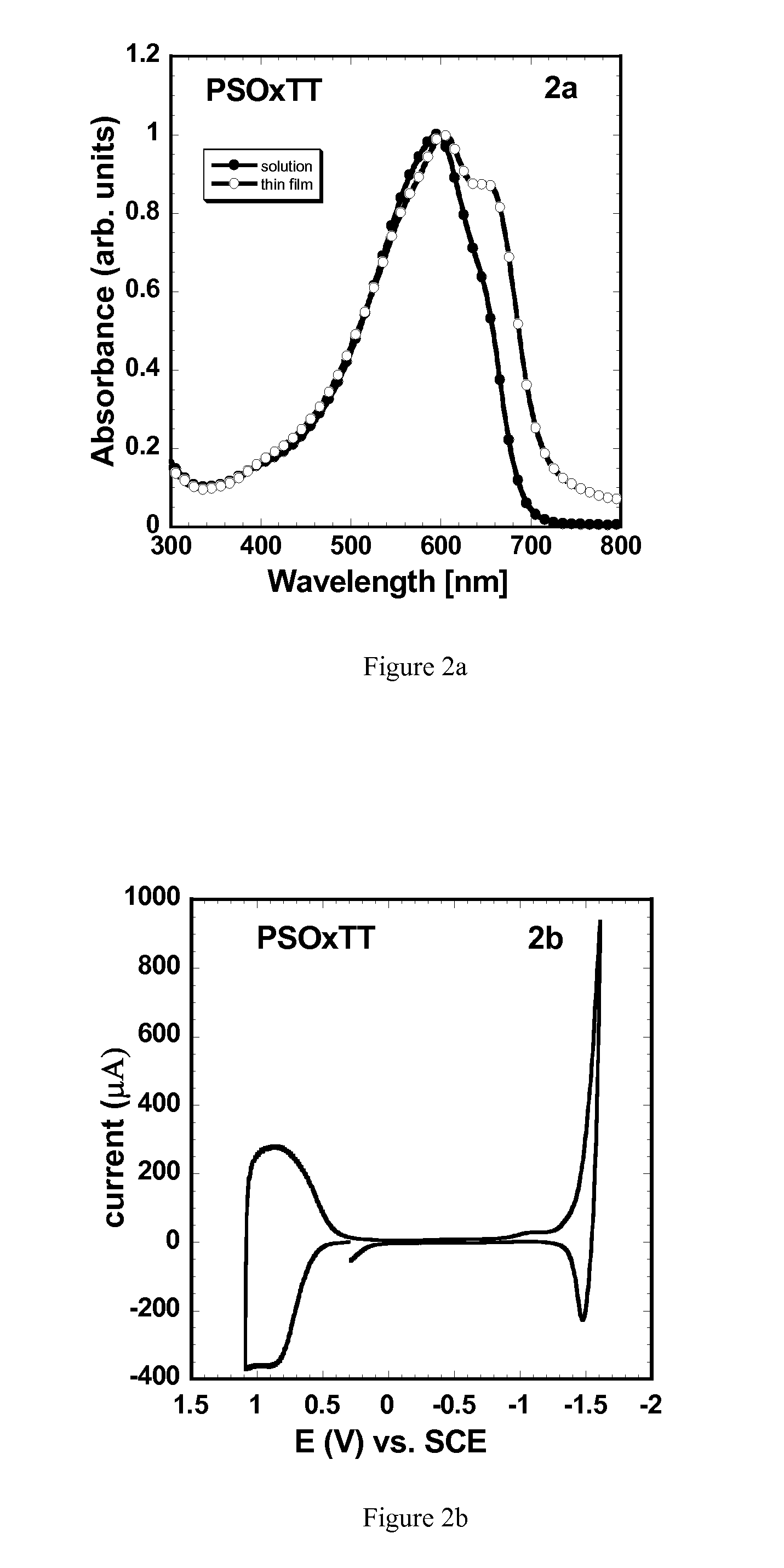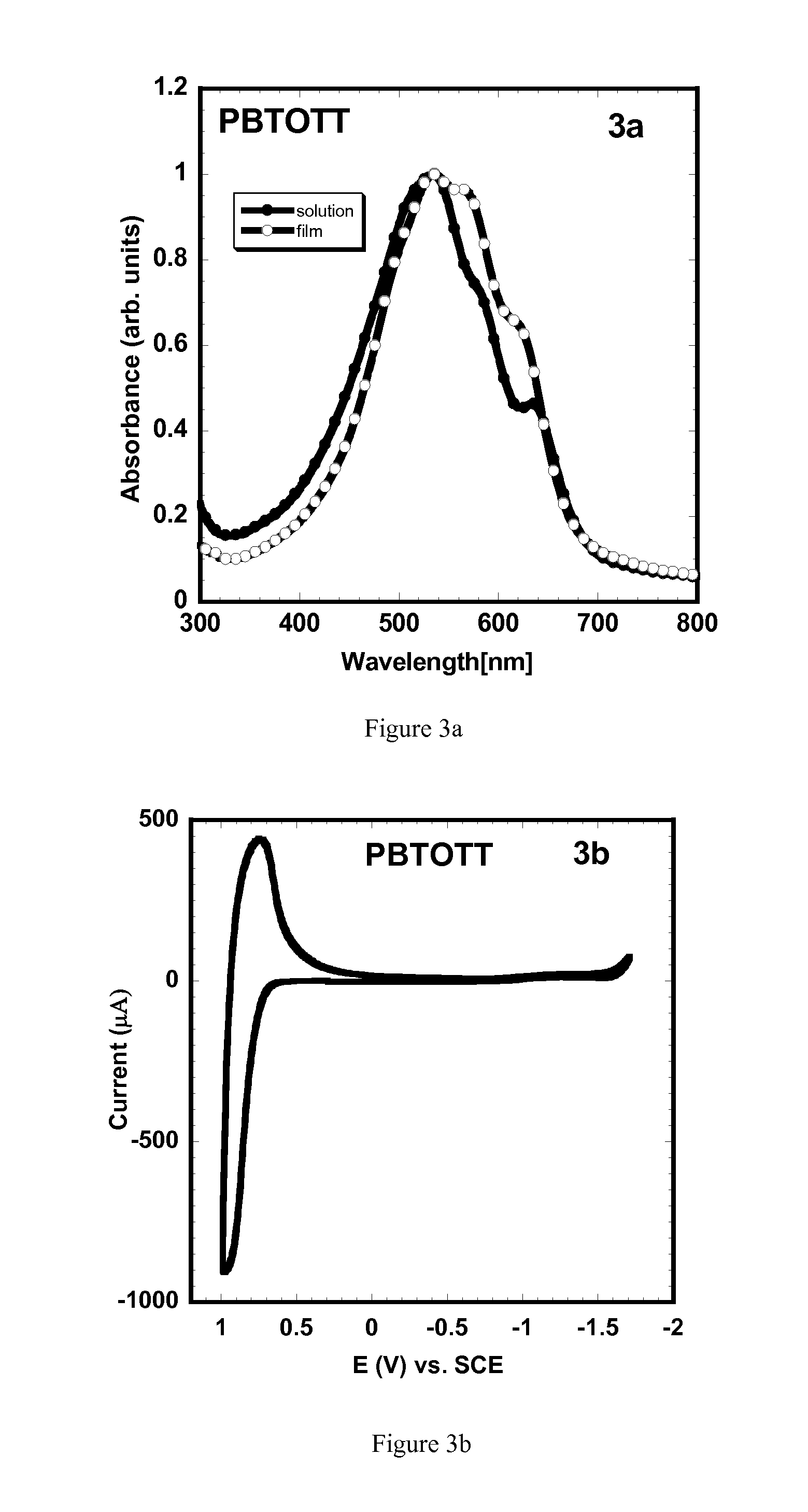Copolymer semiconductors comprising thiazolothiazole or benzobisthiazole, or benzobisoxazole electron acceptor subunits, and electron donor subunits, and their uses in transistors and solar cells
- Summary
- Abstract
- Description
- Claims
- Application Information
AI Technical Summary
Benefits of technology
Problems solved by technology
Method used
Image
Examples
example 1
Synthesis of Poly[(4,4′-bis(2-octyl)dithieno[3,2-b:″,3′-d]silole)-2,6-diyl-alt-(2,5-bis(3-octylthiophen-2-yl)thiazolo[5,4-d]thiazole) (PSOTT)
[0197]
[0198](1) 2,5-Bis(3-octyl-5-(trimethylstannyl)thiophen-2-yl)thiazolo[5,4-d]thiazole (6).
[0199]The compound 6 and it's dibromide precursor were prepared as reported in the literature, see (a) Osaka, I.; Sauve', G.; Zhang, R.; Kowalewski, T.; McCullough, R. D. Adv. Mater. 2007, 19, 4160. (b) Osaka, I.; Zhang, R.; Sauve', G.; Smilgies, D-M.; Kowalewski, T.; McCullough, R. D. J. Am. Chem. Soc. 2009, 131, 2521-2529 all hereby incorporated herein by reference for their disclosures of teachings related synthetic methods.
[0200]Brown solid, (yield; 89%). 1H NMR (300 MHz, CDCl3) δ 7.06 (s, 2H), 3.00 (t, 4H, J=7.8 Hz), 1.72-1.77 (m, 4H), 1.31-1.48 (m, 20H), 0.89-0.91 (m, 6H), 0.53 (s, 18H). EI: M / e 856.5.
[0201]5,5′-diromo-di-n-octylsilylene-2,2′-bithiophene (11).
[0202]The dibromide 11 and its corresponding distannane monomer were prepared as reporte...
example 2
Synthesis of Poly[(4,4′-bis(2-octyl)dithieno[3,2-b:″,3′-d]silole)-2,6-diyl-alt-(2,5-bis(3-octyloxythiophen-2-yl)thiazolo[5,4-d]thiazole)] (PSOxTT)
[0208]The synthetic pathway leading to the synthesis of PSOxTT polymer is outlined below.
[0209]3-octoxythiophene (2′): A mixture of 3-methoxythiophene (7.28 g, 63.76 mmol), 1-octanol (20.09 mL, 127.53 mmol), p-toluenesulfonic acid monohydrate (1.21 g, 6.38 mmol) and 60 mL toluene was heated in a 130° C. bath for 15 hours under argon. After dichloromethane / water extraction, the organic layer was dried over anhydrous Na2SO4. After solvent evaporation, the residue was purified by column chromatography (silica gel 3:1 hexane:dichloromethane) to give 2′ as a colorless solid (13.00 g, 96%). 1H NMR (CDCl3, 300 MHz, ppm): δ 7.18-7.21 (m, 1H), 6.78-6.80 (m, 1H), 6.25-6.26 (m, 1H), 3.97 (t, 2H, 6.6 Hz), 1.76-1.85 (m, 2H), 1.33-1.48 (m, 10H), 0.91-0.95 (m, 3H).
[0210]2-Formyl-3-octoxythiophene (3′):
[0211]To the stirred solution of anhydrous DMF (10 mL...
example 3
Comparative Examples of Polymers not Having a Second Electron Donor Subunit: Poly(2,5-bis(3-octyl-5-(3-octylthiophen-2-yl)thiophen-2-yl)thiazolo[5,4-d]thiazole) (PBTOTT)
[0222]Copolymers comprising thiazolothiazole and alkyl-substituted thiophene subunits similar to those of PSOTT and PSOxTT, but lacking a second type of electron donor subunit, such as the dithienosilole subunits of PSOTT and PSOxTT, were reported in WO 2007 / 145482. Those polymers were demonstrated to be useful for making transistors, but no solar cells comprising those polymers were reported. Representative examples of the polymers of WO 2007 / 145482 (i.e. PBTOTT and PBTOxTT as described below) are provided below for purposes of comparison with PSOTT and PSOxTT, and their uses for making solar cells are provided.
[0223]Preparation of Poly(2,5-bis(3-octyl-5-(3-octylthiophen-2-yl)thiophen-2-yl)thiazolo[5,4-d]thiazole) (PBTOTT), was carried out through a Stille coupling reaction of distannane monomer 6 and dibromo compou...
PUM
| Property | Measurement | Unit |
|---|---|---|
| Temperature | aaaaa | aaaaa |
| Temperature | aaaaa | aaaaa |
| Temperature | aaaaa | aaaaa |
Abstract
Description
Claims
Application Information
 Login to View More
Login to View More - R&D
- Intellectual Property
- Life Sciences
- Materials
- Tech Scout
- Unparalleled Data Quality
- Higher Quality Content
- 60% Fewer Hallucinations
Browse by: Latest US Patents, China's latest patents, Technical Efficacy Thesaurus, Application Domain, Technology Topic, Popular Technical Reports.
© 2025 PatSnap. All rights reserved.Legal|Privacy policy|Modern Slavery Act Transparency Statement|Sitemap|About US| Contact US: help@patsnap.com



